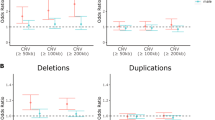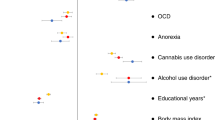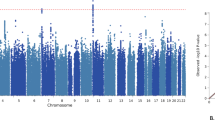Abstract
Attention deficit/hyperactivity disorder (ADHD) is a childhood-onset disorder characterized by marked inattention, hyperactivity and impulsivity. The dopaminergic system has been hypothesized to be involved in the development of ADHD. Positive associations have been found for the dopamine receptors D1 and D5 genes, suggesting that other genes involved in D1/D5 signalling may also contribute to ADHD. In this study, we tested the calcyon gene (DRD1IP), which encodes a brain-specific D1-interacting protein involved in D1/D5 receptors calcium signalling, for association with ADHD. The inheritance of nine polymorphisms in the calcyon gene was examined in a sample of 215 nuclear families, with 260 affected children, using the transmission/disequilibrium test. The most common haplotype, designated C1, demonstrated significant evidence for excess transmission. Quantitative trait analyses of this haplotype showed significant relationships with both the inattentive (parent's rating, P=0.006; teacher's rating, P=0.003) and hyperactive/impulsive (parent's rating, P=0.004) dimensions of the disorder. Two of the nine marker alleles included in haplotype C1, rs4838721A located ∼10 kb 5′ of the gene and rs2275723C located 10 bp upstream of the exon 5 acceptor splice site, also showed significant evidence for association when analysed individually. As these two variants are not predicted to alter calcyon function, we screened the gene exons by sequencing. No variation in the coding region was identified, suggesting that a causal variant allele resides elsewhere in a regulatory sequence of the gene. These findings support the proposed involvement of the calcyon gene in ADHD and implicate haplotype C1 as containing a risk allele.
This is a preview of subscription content, access via your institution
Access options
Subscribe to this journal
Receive 12 print issues and online access
$259.00 per year
only $21.58 per issue
Buy this article
- Purchase on Springer Link
- Instant access to full article PDF
Prices may be subject to local taxes which are calculated during checkout

Similar content being viewed by others
References
Barr CL, Swanson JM, Kennedy JL . Molecular Genetics of ADHD. In: Levy F, Hay D, (eds). Attention, Genes and ADHD. Taylor and Francis Inc.: Philadelphia, PA, 2001, pp 173–195.
Thapar A, Holmes J, Poulton K, Harrington R . Genetic basis of attention deficit and hyperactivity. Br J Psychiatry 1999; 174: 105–111.
Faraone SV, Biederman J . Neurobiology of attention-deficit hyperactivity disorder. Biol Psychiatry 1998; 44: 951–958.
Seeman P, Madras BK . Anti-hyperactivity medication: methylphenidate and amphetamine. Mol Psychiatry 1998; 3: 386–396.
Durston S . A review of the biological bases of ADHD: what have we learned from imaging studies? Ment Retard Dev Disabil Res Rev 2003; 9: 184–195.
Viggiano D, Ruocco LA, Sadile AG . Dopamine phenotype and behaviour in animal models: in relation to attention deficit hyperactivity disorder. Neurosci Biobehav Rev 2003; 27: 623–637.
Davids E, Zhang K, Tarazi FI, Baldessarini RJ . Animal models of attention-deficit hyperactivity disorder. Brain Res Brain Res Rev 2003; 42: 1–21.
Heiser P, Friedel S, Dempfle A, Konrad K, Smidt J, Grabarkiewicz J et al. Molecular genetic aspects of attention-deficit/hyperactivity disorder. Neurosci Biobehav Rev 2004; 28: 625–641.
Faraone SV, Doyle AE, Mick E, Biederman J . Meta-analysis of the association between the 7-repeat allele of the dopamine D(4) receptor gene and attention deficit hyperactivity disorder. Am J Psychiatry 2001; 158: 1052–1057.
Lowe N, Kirley A, Hawi Z, Sham P, Wickham H, Kratochvil CJ et al. Joint analysis of the DRD5 marker concludes association with attention-deficit/hyperactivity disorder confined to the predominantly inattentive and combined subtypes. Am J Hum Genet 2004; 74: 348–356.
Misener VL, Luca P, Azeke O, Crosbie J, Waldman I, Tannock R et al. Linkage of the dopamine receptor D1 gene to attention-deficit/hyperactivity disorder. Mol Psychiatry 2004; 9: 500–509.
Bobb AJ, Addington AM, Sidransky E, Gornick MC, Lerch JP, Greenstein DK et al. Support for association between ADHD and two candidate genes: NET1 and DRD1. Am J Med Genet B Neuropsychiatr Genet 2005; 134: 67–72.
Kirley A, Hawi Z, Daly G, McCarron M, Mullins C, Millar N et al. Dopaminergic system genes in ADHD: toward a biological hypothesis. Neuropsychopharmacology 2002; 27: 607–619.
Zhuang X, Belluscio L, Hen R . G(olf)alpha mediates dopamine D1 receptor signaling. J Neurosci 2000; 20: RC91.
Undie AS, Friedman E . Stimulation of a dopamine D1 receptor enhances inositol phosphates formation in rat brain. J Pharmacol Exp Ther 1990; 253: 987–992.
Wang HY, Undie AS, Friedman E . Evidence for the coupling of Gq protein to D1-like dopamine sites in rat striatum: possible role in dopamine-mediated inositol phosphate formation. Mol Pharmacol 1995; 48: 988–994.
Dreher JK, Jackson DM . Role of D1 and D2 dopamine receptors in mediating locomotor activity elicited from the nucleus accumbens of rats. Brain Res 1989; 487: 267–277.
Meyer ME . Effects of intraaccumbens dopamine agonist SK&F38393 and antagonist SCH23390 on locomotor activities in rats. Pharmacol Biochem Behav 1993; 45: 843–847.
Beninger RJ, Miller R . Dopamine D1-like receptors and reward-related incentive learning. Neurosci Biobehav Rev 1998; 22: 335–345.
Goldman-Rakic PS, Muly III EC, Williams GV . D(1) receptors in prefrontal cells and circuits. Brain Res Brain Res Rev 2000; 31: 295–301.
Barkley RA . Behavioral inhibition, sustained attention, and executive functions: constructing a unifying theory of ADHD. Psychol Bull 1997; 121: 65–94.
McNamara FN, Clifford JJ, Tighe O, Kinsella A, Drago J, Croke DT et al. Congenic D1A dopamine receptor mutants: ethologically based resolution of behavioural topography indicates genetic background as a determinant of knockout phenotype. Neuropsychopharmacology 2003; 28: 86–99.
El-Ghundi M, Fletcher PJ, Drago J, Sibley DR, O'Dowd BF, George SR . Spatial learning deficit in dopamine D(1) receptor knockout mice. Eur J Pharmacol 1999; 383: 95–106.
Sunahara RK, Guan HC, O'Dowd BF, Seeman P, Laurier LG, Ng G et al. Cloning of the gene for a human dopamine D5 receptor with higher affinity for dopamine than D1. Nature 1991; 350: 614–619.
Tiberi M, Jarvie KR, Silvia C, Falardeau P, Gingrich JA, Godinot N et al. Cloning, molecular characterization, and chromosomal assignment of a gene encoding a second D1 dopamine receptor subtype: differential expression pattern in rat brain compared with the D1A receptor. Proc Natl Acad Sci USA 1991; 88: 7491–7495.
Holmes A, Hollon TR, Gleason TC, Liu Z, Dreiling J, Sibley DR et al. Behavioral characterization of dopamine D5 receptor null mutant mice. Behav Neurosci 2001; 115: 1129–1144.
Centonze D, Grande C, Saulle E, Martin AB, Gubellini P, Pavon N et al. Distinct roles of D1 and D5 dopamine receptors in motor activity and striatal synaptic plasticity. J Neurosci 2003; 23: 8506–8512.
Lezcano N, Mrzljak L, Eubanks S, Levenson R, Goldman-Rakic P, Bergson C . Dual signaling regulated by calcyon, a D1 dopamine receptor interacting protein. Science 2000; 287: 1660–1664.
Bergson C, Levenson R, Goldman-Rakic PS, Lidow MS . Dopamine receptor-interacting proteins: the Ca(2+) connection in dopamine signaling. Trends Pharmacol Sci 2003; 24: 486–492.
Zelenin S, Aperia A, Diaz Heijtz R . Calcyon in the rat brain: cloning of cDNA and expression of mRNA. J Comp Neurol 2002; 446: 37–45.
Oakman SA, Meador-Woodruff JH . Calcyon transcript expression in macaque brain. J Comp Neurol 2004; 468: 264–276.
Fisher SE, Francks C, McCracken JT, McGough JJ, Marlow AJ, MacPhie IL et al. A genomewide scan for loci involved in attention-deficit/hyperactivity disorder. Am J Hum Genet 2002; 70: 1183–1196.
Petit P, Devriendt K, Azou M, Gewillig M, Fryns JP . Terminal deletion of chromosome 10q26: delineation of two clinical phenotypes. Genet Couns 1998; 9: 271–275.
Irving M, Hanson H, Turnpenny P, Brewer C, Ogilvie CM, Davies A et al. Deletion of the distal long arm of chromosome 10: is there a characteristic phenotype? A report of 15 de novo and familial cases. Am J Med Genet 2003; 123A: 153–163.
Ickowicz A, Schachar R, Sugarman R, Chen S, Millette C, Cook L et al. Reliability and validity of the Parent Interview for Child Symptoms (PICS). Paper presented at the Proceedings of the 49th Annual Meeting of the American Academy of Child and Adolescent Psychiatry, October 22–27, 2002, San Francisco, CA.
Tannock R, Hum M, Masellis M, Humphries T, Schachar R . Teacher Telephone Interview for Children's Academic Performance, Attention, Behaviour and Learning: DSM-IV Version (TTI-IV). Unpublished document, The Hospital for Sick Children: Toronto, Canada 2002.
Conners CK . Conners' Rating Scales-Revised. Multi-Health Systems: Toronto, Canada, 1997.
Boyle MH, Offord DR, Racine Y, Fleming JE, Szatmari P, Sanford M . Evaluation of the revised Ontario Child Health Study scales. J Child Psychol Psychiatry 1993; 34: 189–213.
Wilkinson GS . Wide Range Achievement Test 3-Revision 3. Jastak Associates: Wilmington, DE, 1993.
Semel E, Wing E, Secord W . Clinical Evaluation of Language Fundamentals, 3rd edn (CELF-3) The Psychological Corporation: San Antonio, TX, 1995.
Kovacs M . Mannual: The Children's Depression Inventory. Multi-Health Systems: Toronto, Canada, 1995.
Reynolds CR, Richmond BO . What I Think and Feel (RCMAS). Western Psychological Services: Los Angeles, CA, 1985.
Wechsler DI . Wechsler Intelligence Scale for Children, 3rd edn. The Psychological Corporation: New York, NY, 1991.
Miller SA, Dykes DD, Polesky HF . A simple salting out procedure for extracting DNA from human nucleated cells. Nucleic Acids Res 1988; 16: 1215.
Livak KJ, Flood SJ, Marmaro J, Giusti W, Deetz K . Oligonucleotides with fluorescent dyes at opposite ends provide a quenched probe system useful for detecting PCR product and nucleic acid hybridization. PCR Methods Appl 1995; 4: 357–362.
Sham PC, Curtis D . An extended transmission/disequilibrium test (TDT) for multi-allele marker loci. Ann Hum Genet 1995; 59 (Part 3): 323–336.
Clayton D . A generalization of the transmission/disequilibrium test for uncertain-haplotype transmission. Am J Hum Genet 1999; 65: 1170–1177.
Horvath S, Xu X, Laird NM . The family based association test method: strategies for studying general genotype–phenotype associations. Eur J Hum Genet 2001; 9: 301–306.
Dudbridge F . Pedigree disequilibrium tests for multilocus haplotypes. Genet Epidemiol 2003; 25: 115–121.
Spielman RS, McGinnis RE, Ewens WJ . Transmission test for linkage disequilibrium: the insulin gene region and insulin-dependent diabetes mellitus (IDDM). Am J Hum Genet 1993; 52: 506–516.
Zhang J, Wong H, Ramanan S, Cheong D, Leong A, Hooi SC . The proline-rich acidic protein is epigenetically regulated and inhibits growth of cancer cell lines. Cancer Res 2003; 63: 6658–6665.
Sherry ST, Ward MH, Kholodov M, Baker J, Phan L, Smigielski EM et al. dbSNP: the NCBI database of genetic variation. Nucleic Acids Res 2001; 29: 308–311.
The International HapMap Consortium. The International HapMap Project. Nature 2003; 426: 789–796.
Thapar A, Harrington R, Ross K, McGuffin P . Does the definition of ADHD affect heritability? J Am Acad Child Adolesc Psychiatry 2000; 39: 1528–1536.
Sherman DK, McGue MK, Iacono WG . Twin concordance for attention deficit hyperactivity disorder: a comparison of teachers' and mothers' reports. Am J Psychiatry 1997; 154: 532–535.
Nadder TS, Silberg JL, Rutter M, Maes HH, Eaves LJ . Comparison of multiple measures of ADHD symptomatology: a multivariate genetic analysis. J Child Psychol Psychiatry 2001; 42: 475–486.
Martin N, Scourfield J, McGuffin P . Observer effects and heritability of childhood attention-deficit hyperactivity disorder symptoms. Br J Psychiatry 2002; 180: 260–265.
Lezcano N, Bergson C . D1/D5 dopamine receptors stimulate intracellular calcium release in primary cultures of neocortical and hippocampal neurons. J Neurophysiol 2002; 87: 2167–2175.
Acknowledgements
This work was supported by Postdoctoral Fellowships from the Hospital for Sick Children Research Training Centre (NL and VLM) and by grants from The Hospital for Sick Children Psychiatric Endowment Fund (CLB), and the Canadian Institutes of Health Research MT14336 and MOP14334 (CLB).
Author information
Authors and Affiliations
Corresponding author
Additional information
Supplementary Information accompanies the paper on the Molecular Psychiatry website (http://www.nature.com/mp)
Rights and permissions
About this article
Cite this article
Laurin, N., Misener, V., Crosbie, J. et al. Association of the calcyon gene (DRD1IP) with attention deficit/hyperactivity disorder. Mol Psychiatry 10, 1117–1125 (2005). https://doi.org/10.1038/sj.mp.4001737
Received:
Revised:
Accepted:
Published:
Issue Date:
DOI: https://doi.org/10.1038/sj.mp.4001737
Keywords
This article is cited by
-
Effects of antenatal dexamethasone treatment on glucocorticoid receptor and calcyon gene expression in the prefrontal cortex of neonatal and adult common marmoset monkeys
Behavioral and Brain Functions (2010)
-
Candidate gene studies of ADHD: a meta-analytic review
Human Genetics (2009)
-
Phylogenetic Analysis of the NEEP21/Calcyon/P19 Family of Endocytic Proteins: Evidence for Functional Evolution in the Vertebrate CNS
Journal of Molecular Evolution (2009)
-
No preferential transmission of paternal alleles at risk genes in attention-deficit hyperactivity disorder
Molecular Psychiatry (2007)
-
Association of the dopamine receptor D1 gene, DRD1, with inattention symptoms in families selected for reading problems
Molecular Psychiatry (2007)



